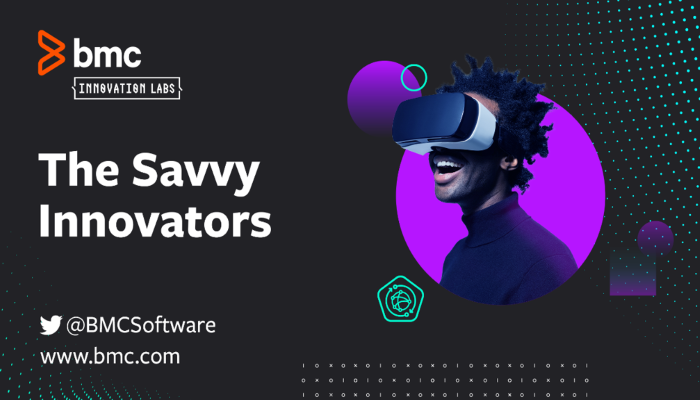We hear a lot these days about the urgency of digital transformation—how it’s an existential necessity for every organization, and the faster, the better. But what do we really mean by that term? Is it simply a matter of delivering new digital services to customers and employees? What about recycling existing physical infrastructure to accelerate innovation? Using environmental, social, and governance (ESG) projects to foster creative thinking? Making mobility and automation key elements of your talent recruitment efforts? And how do you measure the impact of such diverse initiatives to make sure they’re more than just interesting ideas?
The Savvy Innovators, a new Voice of America podcast series sponsored by BMC, explores how enterprises can embrace tech-enabled disruption, and continuously adapt and evolve to achieve and sharpen their competitive edge. In a recent episode, Bill Corrigan, VP of Technology Strategy and Advocacy at BMC, and Surya Panditi, Former CEO of Enel X North America, joined host Bonnie D. Graham to share their views and firsthand experiences with digital transformation across companies and industries. Highlights of their conversation follow.
The digital transformation imperative
In a business environment where disruption is the new normal, organizations are under pressure to optimize existing technologies while driving innovation. They have to meet the expectations of a new generation of talent, including a commitment to ESG, while leveraging data to make better decisions, improve performance, and reduce operational risk. It’s quite a list—and the margin for error is small. As Bill observes, “Whether you want to transform your business with technology or not, it’s going to be forced upon you. If you don’t get it right, you really can screw up not only your digital assets but your entire company.”
Reusing rather than reinventing
Digital transformation doesn’t have to be driven entirely by net-new innovations. Surya and Bill discuss examples of organizations finding ways to drive new forms of value with existing investments, including at Surya’s former company. “When you’re looking at building renewable-energy-[based], utility-scale plants, there’s the actual generation that you have to build, but you also have to connect it to [existing] transmission systems and distribution systems,” Surya explains. “Very often it is that interconnection that tends to be both challenging from an environmental, regulatory perspective as well as from a financial perspective.” To solve this problem, Enel X decided to transform its existing fossil-fuel-based-generation plants and associated substations to accommodate new clean-energy technologies.
“Obviously, wherever you can reuse technology or existing investments, that’s better than having to reinvent the wheel,” notes Bill, who cited a similar example from a large military installation. While organizations often think of digital innovation in terms of advanced technologies and ambitious implementations, smaller investments can also deliver exceptional returns. “A tiny bit of technology addition in the form of data normalization and data integration was able to save this particular military base about eight million dollars a year while providing much better service for the people living and working there. It paid for itself in a few months,” he says.
Making ESG measurable—and inspirational
ESG objectives have quickly become a top-level priority for modern organizations. It’s a broad umbrella, encompassing everything from sustainability and socially conscious decision-making to diversity, equity, and inclusion (DEI), with a common theme of going beyond technology transformations to necessitate cultural evolution, as well. “A lot of ESG is about transparency—showing people why it’s important,” says Bill.
Measurement can be a big part of this cultural change. “Measurement is important because you can say everything you want and give it lip service, but at the end [of the day], people are being held accountable,” says Surya. “Companies are being held accountable for what they’re actually doing, which is a marked difference to the kind of greenwashing that was happening a few years ago.”
Establishing ESG as a core corporate value can also provide new channels to stimulate employee creativity and problem-solving. During Surya’s tenure at Enel X, a young leader in the company’s Boston office launched a hackathon that drew a number of interesting projects beyond the usual improvements to existing products and services. One team proposed to reduce the environmental impact of their daily lunches. “They came up with a set of steps that we would take in order to reduce trash, increase reusable containers, [and] use compostable forks and spoons and knives. They went around to many of the restaurants in the neighborhood and convinced them to reduce their trash footprint,” he recalls. By encouraging employees to think outside the box—and even outside the company itself—companies can foster a more fertile environment for business innovation.
Rethinking employee experience
An ESG focus can also be a powerful tool for recruiting, retaining, and engaging a competitive workforce. Surya describes his Enel X workforce as having been highly mission-driven. “I will tell you the fact that they were working on clean technology meant more to them than necessarily getting the next bonus or raise.”
Bill sees great value in allowing more flexibility and mobility in where and how people can work, as well as increasing automation both at the manufacturing level and in the office to create a better employee experience. Both are key to hiring a new born-digital generation of talent. “If you can attract and retain those younger people, you are more likely to have a higher EBITDA than others in your category,” he observes. “Oftentimes, this falls back to data and being able to measure your efforts.”
Data, data, data
Again and again, Bill and Surya circled back to the central role of data in digital transformation. “People tend to think about digital transformation, data analytics, and machine learning as technologies we can apply to specific technical business problems, but if you take a step back, it’s across all industries, all functions, all types of outcomes. We need to do a good job of not only tapping into the data but analyzing it, coming up with insights, presenting options, and then measuring results, whether it’s employee engagement or making a process more efficient,” says Surya.
To date, companies have been falling far short in this effort. Bill cited a recent study showing that only a tiny fraction of the data produced in 2020 was actually utilized and analyzed in 2021 to make any changes to business results. “The idea is that we’re capturing a lot of data but we’re not operationalizing or turning it into valuable business insights or bottom line,” he says.
To hear Bill and Surya’s recommendations on solving the digital transformation data challenge, along with their thoughts on topics from robots and ethical artificial intelligence (AI) to the definition of success, listen to the whole podcast here: “Driving Business Results with Digital Transformation.”
These postings are my own and do not necessarily represent BMC's position, strategies, or opinion.
See an error or have a suggestion? Please let us know by emailing blogs@bmc.com.






